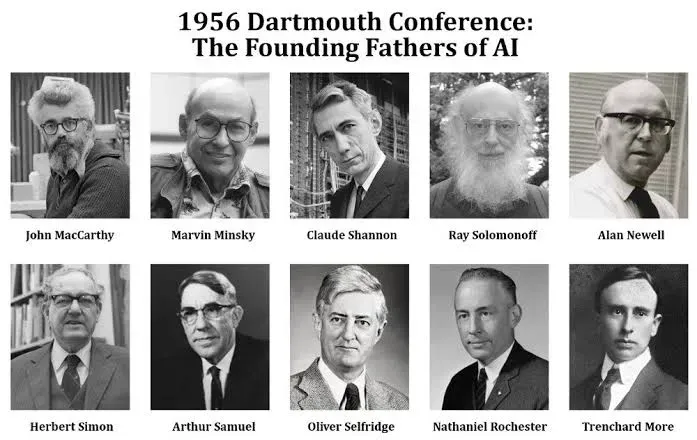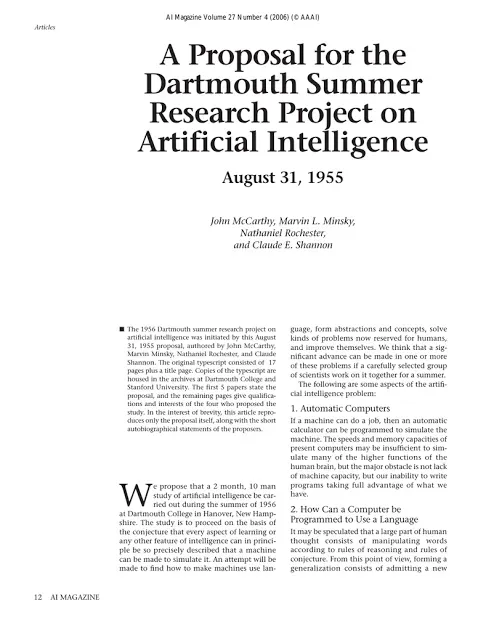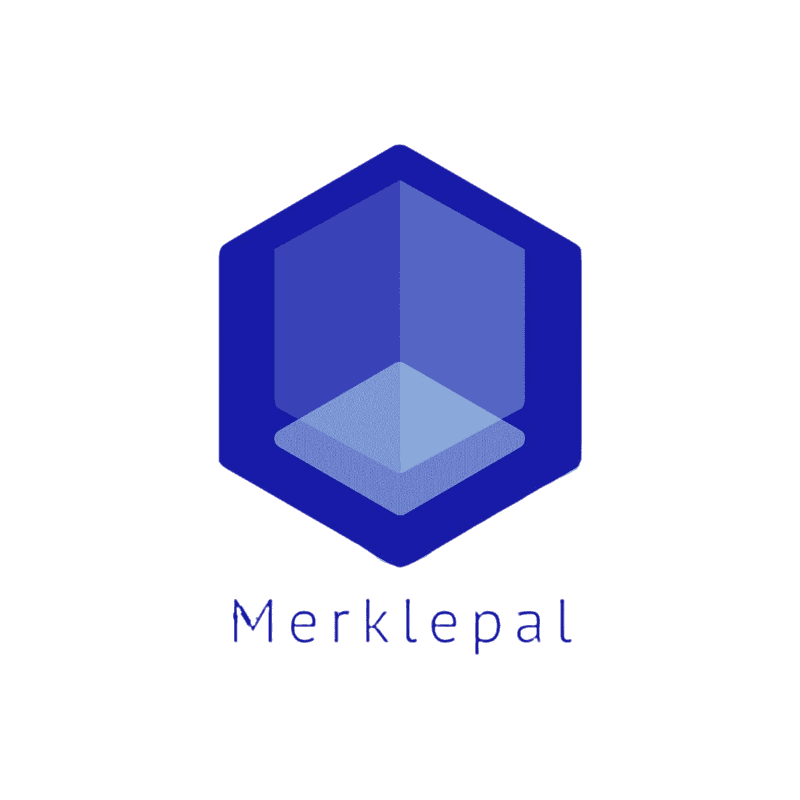The Birth of Artificial Intelligence (AI): Journey Through AI Milestones
In the realm of cutting-edge technology, Artificial Intelligence (AI) stands as a beacon of innovation, solving intricate problems with a prowess akin to human and animal intelligence, as described by Yann Lecunn, Meta's Chief AI Scientist.

one concept has captured the human imagination for decades—Artificial Intelligence (AI). The roots of AI trace back to the mid-20th century, where ambitious minds dared to dream of machines with the ability to emulate human intelligence.
The term "artificial intelligence" was first coined in 1956 at the Dartmouth Conference, a pivotal moment that marked the official birth of the AI field. Early pioneers, including John McCarthy, Marvin Minsky, Allen Newell, and Herbert A. Simon, envisioned creating machines capable of symbolic reasoning and problem-solving.

The initial years were marked by optimism but limited progress. AI researchers faced challenges in creating machines that could truly mimic human cognitive functions. The 1970s and 1980s brought a period of skepticism and reduced funding, known as the "AI winter." Progress seemed stalled, and doubts about the feasibility of AI lingered.
The resurgence came in the 1990s with the advent of machine learning. Researchers started exploring algorithms that allowed machines to learn from data and adapt to new information. Neural networks, inspired by the human brain's structure, gained prominence. This era saw breakthroughs in speech recognition and image processing.
The 21st century ushered in a new chapter with the rise of deep learning. Neural networks with multiple layers, known as deep neural networks, enabled AI systems to tackle more complex tasks. From playing games like chess and Go to recognizing intricate patterns in data, AI demonstrated unprecedented capabilities.
it's essential to understand the journey that has brought us to the forefront of this technological revolution.
The Genesis of AI: Turing's Vision (1950s)
Alan Turing, often regarded as the father of computer science, laid the theoretical groundwork, envisioning machines that could mimic human thought processes.
In the annals of technological history, the year 1950 emerges as a pivotal juncture with the unveiling of Alan Turing's work, "Computing Machinery and Intelligence." Turing, a luminary in the realm of computer science, presented a vision that would shape the trajectory of Artificial Intelligence (AI) for decades to come.
In this seminal publication, Turing introduced the concept of the Turing test, a litmus test for gauging a machine's ability to exhibit intelligent behavior indistinguishable from that of a human. This concept not only became a lodestar for early AI researchers but also served as the key to unlocking the doors to a realm where machines could emulate human cognition.
Turing's profound insights laid the foundational stones for what we now recognize as AI. His visionary work opened up new frontiers, challenging the boundaries of what machines could achieve in terms of intelligence and problem-solving. Little did the world know that this seminal moment would mark the inception of a technological revolution that continues to redefine our relationship with machines.
The concept of AI was officially coined in 1956, John McCarthy, Marvin Minsky, Nathaniel Rochester, and Claude Shannon—convened to forge a term that would resonate through the corridors of technological history. This momentous gathering marked the birth of "Artificial Intelligence" (AI), a phrase that would become synonymous with the pursuit of machines endowed with cognitive abilities akin to human intelligence.
‘I had to call it something, so I called it Artificial Intelligence, and I had a vague feeling that I’d heard the phrase before, but in all these years I have never been able to track it down.’ according to John McCarthy
These visionaries, cognizant of the transformative potential of their ideas, crafted the term "artificial intelligence" in a proposal for a workshop. Little did they know that this modest linguistic creation would become the cornerstone of an entire field, heralding a new era in the relationship between humans and machines.

Conversations and Mobile Minds(1960s)
Stanford University's creation, Shakey the robot, marked a significant milestone in the 1960s. As the first mobile robot capable of applying reasoning to its actions, Shakey set the stage for the integration of AI into robotics, hinting at a future where machines could navigate and interact intelligently with their surroundings.
In 1966, Joseph Weizenbaum, a visionary from MIT, unveiled Eliza, a pioneering chatbot. Crafted with cognitive finesse, Eliza simulated a Rogerian psychotherapist, engaging users in text-based conversations that remarkably mirrored human interactions.
Weizenbaum's Eliza laid the foundation for future advancements in AI-driven conversational agents, emphasizing the profound impact of human-computer interaction.
AI's Roller Coaster: Peaks and Valleys (1970s, 1980s)
During the 1970s and 1980s, the field of Artificial Intelligence (AI) embarked on a turbulent journey marked by oscillating tides of enthusiasm and skepticism, colloquially known as "AI summer" and "AI winter."
In these decades, the visionary Marvin Minsky, alongside Roger Schank, foresaw the onset of what they termed an "AI winter" a period of skepticism and reduced funding for AI research. This cautionary prediction cast a shadow over the field, prompting a reevaluation of AI's potential and efficacy.
Deep Learning Unleashed: The 1980s Revolution
The 1980s marked a transformative epoch for Artificial Intelligence with the introduction of deep learning on convolutional neural networks (CNNs). This breakthrough heralded a new era, empowering AI systems to unravel the intricacies of complex data. The term "Deep Learning" was introduced to the machine learning community by Rina Dechter in 1986.
The advent of deep learning on CNNs became a linchpin, propelling advancements in diverse fields. From image and speech recognition to natural language processing, AI systems gained unprecedented capabilities to comprehend and interpret multifaceted information.
AI Triumphs: Deep Blue and Watson(1990s)
In 1997, IBM's Deep Blue made history by defeating world chess champion Garry Kasparov in a landmark chess match. This achievement showcased the computational prowess of AI, demonstrating its ability to outmaneuver a human grandmaster in a game of strategy and intellect.
Fast forward to 2011, IBM's Watson took the spotlight by winning the TV game show "Jeopardy!" This victory was a testament to Watson's advanced question-answering capabilities, navigating the nuances of natural language and trivia with unparalleled efficiency.
Autonomous Vehicles and Beyond (2005)
The unveiling of Stanford University's driverless car, Stanley, in 2005 opened new frontiers in AI application. As the first of its kind, Stanley hinted at the possibilities of AI-driven autonomous vehicles, a concept that has rapidly evolved in recent years.
Stanley's pioneering journey marked a watershed moment in the evolution of transportation technology. Developed at Stanford, this autonomous vehicle showcased the potential for machines to navigate and traverse real-world environments without human intervention.
The successful deployment of Stanley not only demonstrated the feasibility of autonomous driving but also ignited a technological race that has since transformed the automotive industry. The year 2005 stands as a defining chapter, as Stanley ushered in an era where the notion of self-driving cars evolved from a distant dream to a tangible reality, shaping the trajectory of transportation for years to come.
Fei-Fei Li Seeds the AI Boom with ImageNet (2006)
In 2006, a visionary named Fei-Fei Li embarked on a groundbreaking journey by initiating the development of the ImageNet visual database. Although officially introduced in 2009, this database, conceived by Li, became a catalyst for the subsequent AI boom.
The ImageNet database was not merely a collection of images; it was a treasure trove for training and evaluating image recognition algorithms. Its inception paved the way for significant advancements in the field of computer vision, allowing AI systems to comprehend and interpret visual information with unprecedented accuracy.
By 2009, ImageNet had evolved into the cornerstone of an annual competition, challenging researchers and developers to push the boundaries of image recognition algorithms. Fei-Fei Li's visionary work laid the foundation for the AI renaissance, propelling computer vision into the forefront of technological innovation and transforming the way machines perceive and understand the visual world.
Unleashing the Power of GPUs in Deep Learning (2009)
In a pivotal moment in 2009, Rajat Raina, Anand Madhavan, and Andrew Ng published a seminal work titled "Large-Scale Deep Unsupervised Learning Using Graphics Processors." This publication presented a transformative idea: harnessing the computational might of Graphics Processing Units (GPUs) to train large neural networks.
The significance of this research lay in its recognition of GPUs as a potent tool for accelerating the training of neural networks. The parallel processing capabilities of GPUs proved instrumental in handling the complex computations required by deep learning algorithms. This breakthrough paved the way for a paradigm shift in the scalability and efficiency of training large-scale neural networks. The utilization of GPUs in deep learning became a cornerstone, facilitating the rapid advancement of AI capabilities.
AI Milestones - From Superhuman Vision to Voice-Powered Assistance (2011)
The year 2011 marked a dual triumph in the realm of Artificial Intelligence:
1. Superhuman Vision with CNN:
Jürgen Schmidhuber, Dan Claudiu Cireșan, Ueli Meier, and Jonathan Masci achieved a historic milestone by developing the first Convolutional Neural Network (CNN) to attain "superhuman" performance. This groundbreaking CNN claimed victory in the German Traffic Sign Recognition competition, showcasing AI's ability to surpass human capabilities in visual recognition tasks.
2. Siri's Debut:
Simultaneously, Apple introduced Siri, a voice-powered personal assistant, revolutionizing human-machine interaction. Siri could not only understand spoken language but also generate responses and execute actions based on voice requests. This launch marked a pivotal moment in the integration of AI into everyday devices, setting the stage for the widespread adoption of voice-activated technology.
The achievements of 2011 underscored AI's capacity to excel in diverse domains, from visual recognition tasks that mimic human vision to the development of intuitive and conversational interfaces, laying the groundwork for the multifaceted AI landscape we navigate today.
AlphaGo's Triumph - AlphaGo versus Lee Sedol (2016)
2016 witnessed the remarkable victory of Google's AlphaGo, a creation of DeepMind, over a professional human Go player, called Lee Sedol. This triumph stood as a testament to AI's strategic and intuitive abilities, reshaping the landscape of board games and showcasing the depth of machine intelligence.
Go, with its vast number of possible moves, had long been considered a formidable challenge for AI. However, AlphaGo's victory demonstrated the machine's capacity to not only comprehend the complexities of the ancient game but also outmaneuver a skilled human opponent.
AlphaFold Unleashes Scientific Potential - AI Solves Protein Structure Puzzle (2018)
In 2018 witnessed AlphaFold, an innovation by DeepMind, contributing to the solution of a critical problem related to protein structure. This achievement not only showcased the prowess of AI in scientific breakthroughs but also highlighted its transformative impact on unraveling complex biological mysteries.
AlphaFold is an artificial intelligence program developed by DeepMind, a subsidiary of Alphabet, which performs predictions of protein structure.
Proteins, with their intricate structures, are essential components in the machinery of life. AlphaFold's ability to predict and understand these structures marked a paradigm shift in computational biology, where AI emerged as a powerful ally for researchers seeking to decode the fundamental building blocks of living organisms.
Pandemic Response and AI Multimodal (2020)
The 2020s witnessed a convergence of AI advancements with a significant impact on pandemic response and multimodal capabilities:
1. Curial's Rapid COVID-19 Identification:
In response to the global pandemic, the University of Oxford developed Curial, an AI test designed for swift and accurate identification of COVID-19 cases in emergency room patients. This innovative application showcased AI's potential to contribute to healthcare and crisis management.
2. ChatGPT's Conversational Interface:
OpenAI introduced Generative Pre-trained Transformer (ChatGPT), offering a chat-based interface to its GPT-3.5 Language Model (LLM).
OpenAI described GPT-3, a deep-learning model for natural-language with 175 billion parameters, 100x more than the previous version, GPT-2. The model is pre-trained on nearly half a trillion words and achieves state-of-the-art performance on several NLP benchmarks without fine-tuning.
This development marked a stride in enhancing user interaction, providing a conversational AI experience that extends the capabilities of language models.
DALL-E Redefines Creativity in AI (2021)
The year 2021 witnessed the emergence of OpenAI's DALL-E, a model that redefined the boundaries of AI creativity. DALL-E made waves by showcasing its unparalleled ability to generate images based on textual descriptions, ushering in a new era of expansive creative possibilities.
AI Unveilings and Controversies (2022)
The year 2022 was marked by a mix of revelations, advancements, and controversies in the AI landscape:
Lamda's Secrecy Unveiled:
Google software engineer Blake Lemoine found himself at the center of a controversy when he was dismissed by google for divulging secrets related to Language Model for Dialogue Applications (Lamda), a project shrouded in secrecy. Lemoine's claim that Lamda was sentient added fuel to the debate, raising questions about the ethical implications and capabilities of advanced AI systems.
- AlphaTensor's Algorithmic Exploration:
DeepMind made waves with the introduction of AlphaTensor, a tool designed "for discovering novel, efficient, and provably correct algorithms." This unveiling underscored the ongoing pursuit of innovative algorithms, showcasing DeepMind's commitment to pushing the boundaries of AI research. - Intel's Deepfake Defense:
Intel entered the deepfake arena with the claim that its real-time deepfake detector, FakeCatcher, boasted an impressive accuracy rate of 96%. As deepfake technology continued to pose challenges, Intel's solution aimed to provide a robust defense against the malicious use of manipulated media. - ChatGPT's Conversational Interface:
OpenAI continued its trend of providing user-friendly AI interfaces with the release of ChatGPT in November. This chat-based interface, connected to the GPT-3.5 Language Model (LLM), offered users a seamless and interactive way to engage with AI, further democratizing access to advanced language models.
AI Developments and Regulatory Responses in 2023 and Beyond
The year 2023 unfolded as a pivotal chapter in the evolution of artificial intelligence, marked by significant announcements, legal challenges, and regulatory responses:
- Bard's Evolution:
In May, Google revealed a transformative shift in its language model landscape, announcing Bard's transition from LaMDA to PaLM2. This advancement represented a leap forward in language model capabilities, reflecting the ongoing pursuit of more sophisticated AI technologies. - Statement on AI Risk:
By the end of May, a Statement on AI Risk garnered attention as prominent figures such as Geoffrey Hinton, Sam Altman, and Bill Gates, along with numerous AI researchers and tech leaders, emphasized the global priority of mitigating AI-related risks. The message underscored the need for comprehensive measures to address potential societal-scale risks posed by advanced AI. - GPT-4's Multimodal Prowess:
OpenAI further elevated the capabilities of language models with the announcement of GPT-4, a multimodal LLM capable of processing both text and image prompts. This breakthrough highlighted the evolution toward AI systems that seamlessly integrate and understand information from diverse modalities, opening new frontiers for creative expression and problem-solving. - Customizable GPTs:
A notable development in 2023 was the introduction of customizable versions of ChatGPT. Users gained the ability to create bespoke iterations that combined specific instructions, additional knowledge, and a mix of skills. This customization feature represented a step towards more tailored and versatile AI applications. - Legal Action Against Meta and OpenAI:
On July 9, comedian Sarah Silverman filed a class action lawsuit against Meta and OpenAI, alleging copyright infringement. The lawsuit accused the companies of training their large language models on copyrighted works without obtaining proper permissions. - Media Outlets Restrict AI Access:
In August, major news organizations, including the New York Times, CNN, Reuters, and others, took measures to limit OpenAI's GPTBot web crawler's access to their content. The New York Times, in particular, updated its terms of service to explicitly disallow the use of its content in large language models. - US Senate's AI Insight Forum:
Responding to growing concerns about the risks associated with AI, the US Senate organized the inaugural bipartisan "AI Insight Forum" on September 13. The event, spearheaded by Senate Majority Leader Chuck Schumer, brought together senators, industry leaders, civil rights advocates, and CEOs from major tech companies. The forum aimed to familiarize senators with AI's nature, risks, and the necessity for safeguards and legislation. - Executive Order on AI Development:
On October 30, 2023, US President Joe Biden signed the Executive Order on the Safe, Secure, and Trustworthy Development and Use of Artificial Intelligence. This executive action reflected the government's commitment to ensuring responsible and secure AI development, highlighting the importance of ethical considerations and regulatory frameworks in the evolving AI landscape.
The Future of AI: Promises and Challenges
As we stand at the precipice of a future where AI continues to evolve, the promises and challenges are intertwined. From enhancing efficiency in various industries to addressing ethical concerns and ensuring responsible AI development, the journey ahead is both thrilling and complex.
In conclusion, AI's evolution is a testament to human ingenuity and the relentless pursuit of knowledge. As AI becomes an integral part of our daily lives, understanding its roots and staying attuned to its ongoing developments is crucial. The unfolding narrative of AI is a captivating story, one that holds the key to unlocking new dimensions of human-machine collaboration and innovation.




